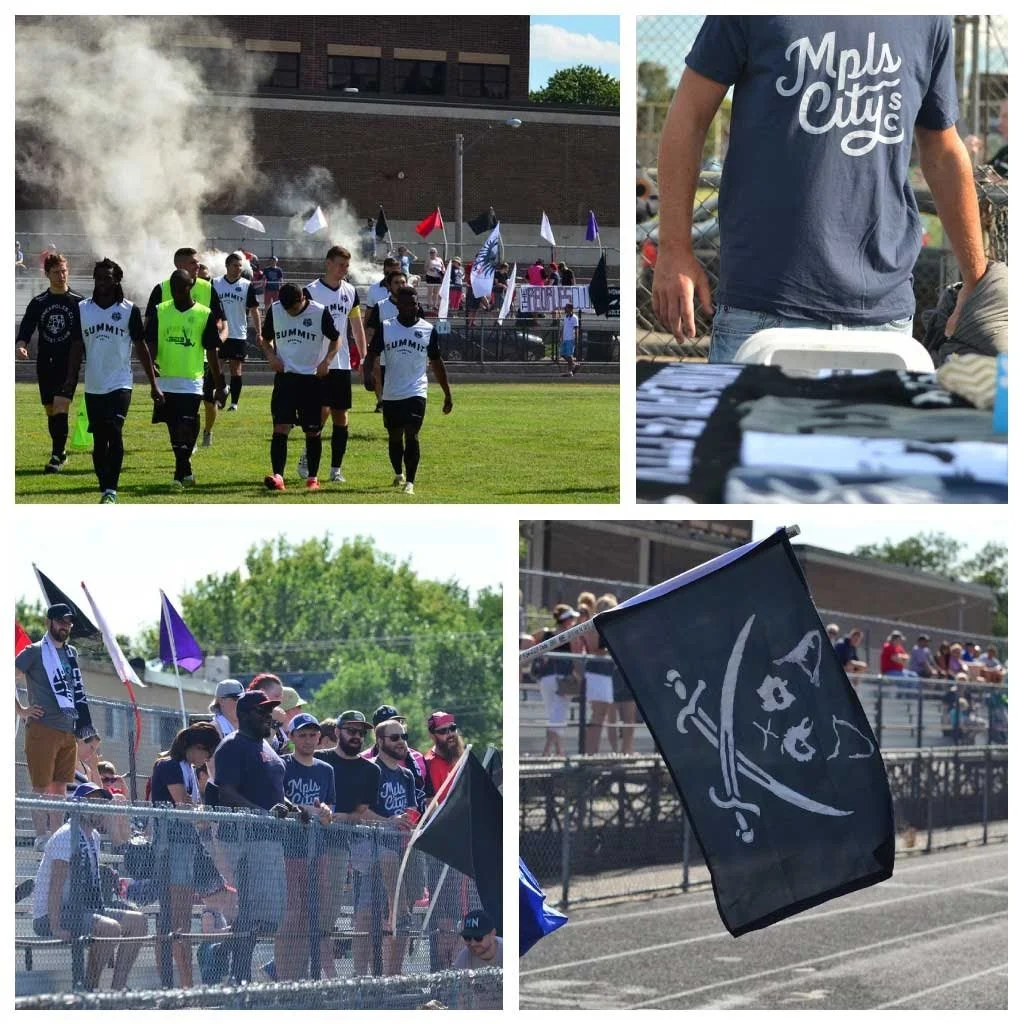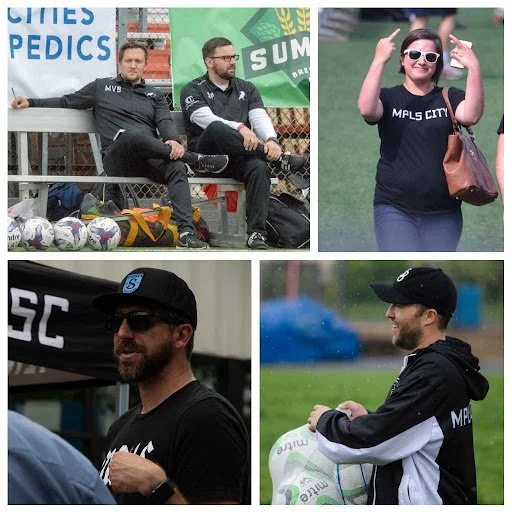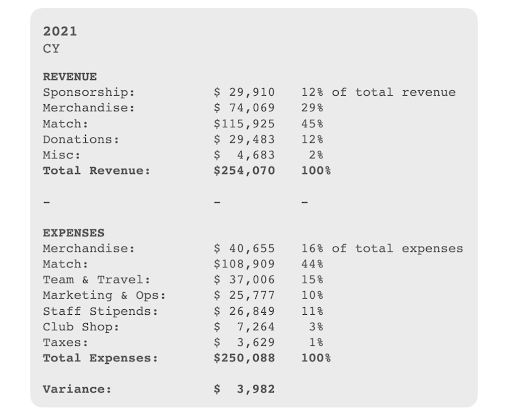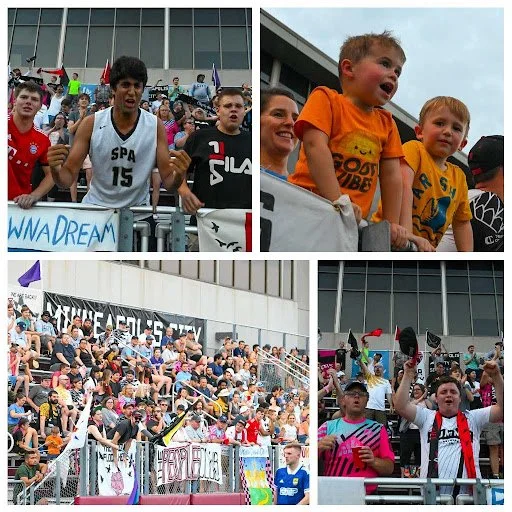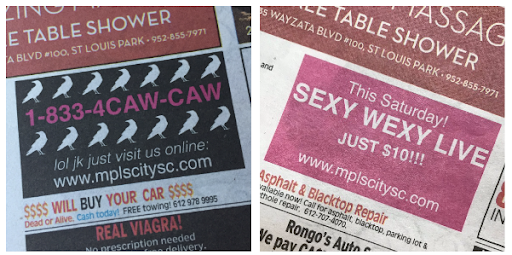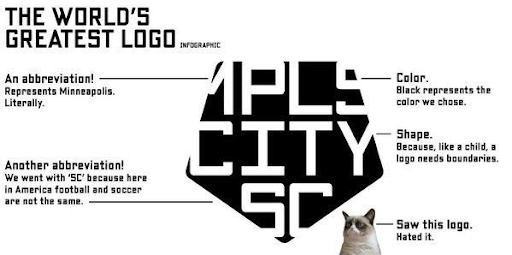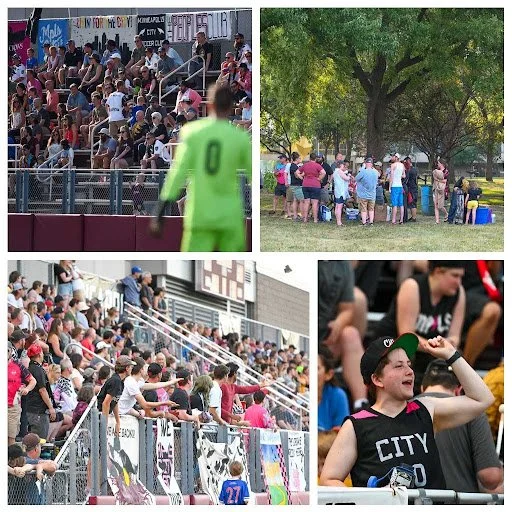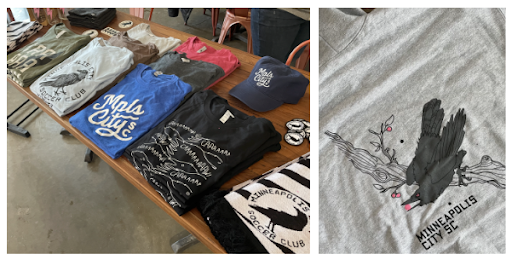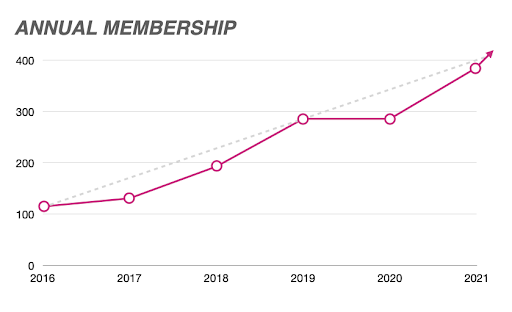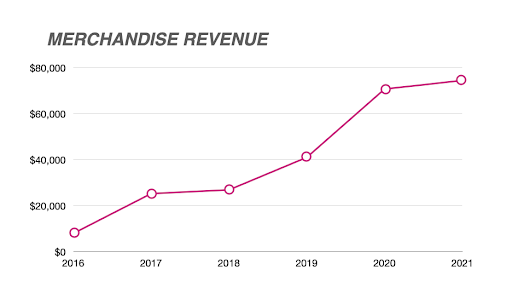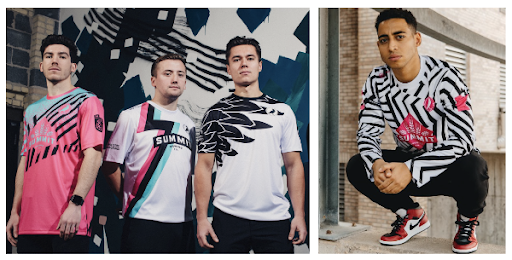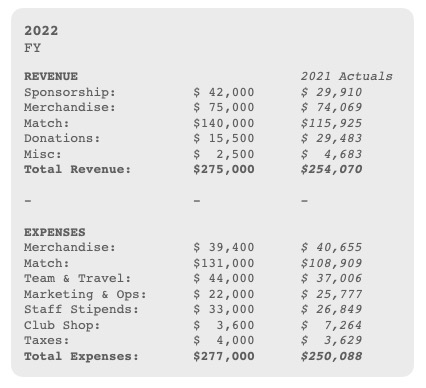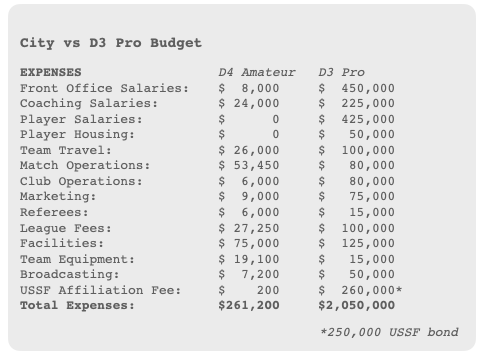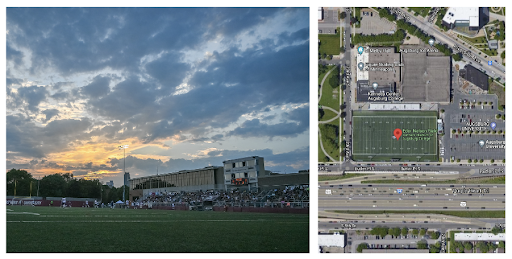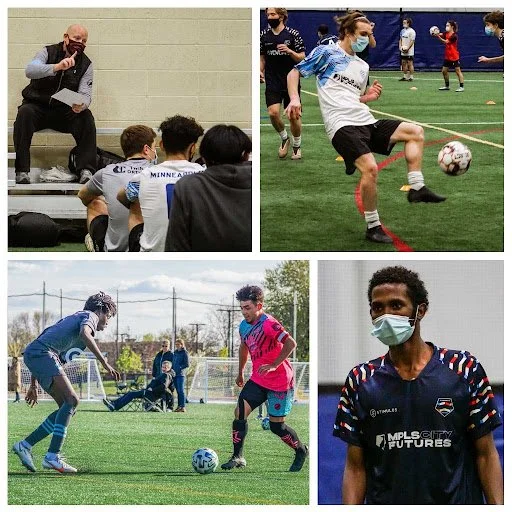2021 MPLS City Financial Recap
This is our third year running MPLS City’s Annual Financial Recap. We do this because we believe it’s vital for clubs looking to mirror City’s highly successful model. We believe in MPLS City, we believe in their approach to running a soccer club, and, as they venture into USL2, we believe that they offer lessons for all of us to learn. This report is equal parts hilarious, educational, and inspiring. Oh, and don’t skip the footnotes! - Dan Vaughn
PART 1.
Every year, I write a recap of our season with a focus on how we did financially because financials are the one part of soccer that nobody ever talks about and the one thing that clubs would most benefit from knowing. – Hoedeman
---
I used to think that American soccer was broken.
I used to think that American soccer was broken and that, because it was broken, the right set of hard working, well-meaning people could fix it. I was enthusiastic about being one of those people.
Instead, it is increasingly clear that American soccer is not broken. It is, like Chris Kessel says, operating exactly as intended.
Structural change is impossible as long as the people in power want it to be impossible, which they do. The structure works quite well for them. There are deep ties that bind, protect, and enrich the current powerbrokers. The only way to have influence is to be rich, powerful, or the college roommate or similar of someone already in power. Being a nobody myself(1), I’ve given up on structural change. The club, our mission, and our people are all that matters.
---
Back when we founded Minneapolis City in late 2015, it was during a massive outburst of creative energy within soccer. It felt like everything was happening and that maybe, now, everything was possible. The NASL was coming apart at the seams in a flurry of righteous anger, laughable incompetence, and lawsuits(2). MLS was growing, with Minnesota and Atlanta United scheduled to join the league in 2017. USL was also on a roll. Louisville City, St Louis FC, and FC Cincinnati(3) were drawing really well, competitive on the field, and seemed like a lot of fun.
It was all happening in the amateur game as well.
Chattanooga FC, founded in 2009, was averaging over 4,000 fans per game on the way to drawing 18,227 in the 2015 NPSL National Final against Cosmos B. What they were doing was so impressive that Don Garber went out of his way to disparage the club.
Detroit City FC, founded in 2012, were on their way to averaging even more fans than Chattanooga and had announced that in 2016 they were going to renovate, move into, and be the anchor tenant at historic Keyworth Stadium. They even ran off a proposed Detroit MLS franchise(4).
Nashville FC, founded in 2013 as a fan-driven club, was drawing thousands of fans in NPSL (and then managed to do a corporate serpentine through USL to MLS and are now Nashville SC).
It was like the beginning of the Earth, when new organisms formed out of the miasma. Clubs like Asheville City, Kingston Stockade, Little Rock Rangers, and Birmingham Legion were all founded at this time. Things were happening! EVERYTHING SEEMED POSSIBLE!!
Except, things were kinda dead in Minnesota.
There was the wreckage of failed clubs like the Minnesota Blast and the Minnesota Kings(5). Minnesota United Reserves (along with Madison 56ers) had just left the NPSL, whereabouts, at the time, unknown. The only remaining clubs in the area, Minnesota TwinStars and La Crosse Aris, had very low profiles and anyway Aris went into hiatus for a year and then they both played in a four-team, non-playoff qualifying provisional NPSL conference the year after. Not much was happening, but the potential was there.
Someone just needed to go first.
There was a real need for a club like City, with the gap that was going to be left when Minnesota United moved to MLS. For players, no longer would the club operate, like it had, especially in the early days, as a sort of Minnesota all-star team and opportunity for local players to get seen and elevate their game--and there was nothing else in the area for top players. For fans, no longer could the club be the ramshackle, general admission, people-sized experience it had been(6). We could fill that gap.
Because nothing existed, we were inventing things as we went along.
While we had experience running teams in the Minnesota Amateur Soccer League, our area’s elite amateur league, there was no roadmap for how we jump from that level of play, with minimal travel, non-existent stadium standards, and the only financial pressure a few guys late on their dues, to the level we wanted to be at: proper Division 4, professionally amateur soccer.
The best that could be said of our first-year operations is that they didn’t stop us from being around today!
In truth, the budget was a potent mix of hopelessly naive and aggressively risk averse. We didn’t know that soccer at this level would work and we didn’t have any money so we were seriously underfunded. We used the money from the first Memberships we sold to buy our first batch of scarves and to pay for the dome for our tryout. Paycheck to paycheck living, baby!
Here is how our first year went(7):
There are three reasons it worked anyway:
We didn’t have any direct competition for players or fans in our market, at our level
The quality of clubs in our first league(8) gave it credibility that its brand name didn’t have
We have only ever tried to be a ramshackle, regular person club and that was both the right level of expectation to set and something that people were into
Here are three things I would have done differently, knowing what I know now:
Spent more on the hype train before we launched. We didn’t market, we just tweeted.
Spent more on merchandise and had runs of t-shirts (multiple designs), sweatshirt, hat, beanie, and scarf ready in the pre-season. We added merch late when we realized people wanted it and that was a missed opportunity.
Spent more on the team, including training, travel, and gear. While we did more than some other clubs, we didn’t do nearly enough for a team at this level.
We should have spent more (assuming we could have found the money), but it worked because the timing was right. If we tried to pull the same thing off today it would never work. Were I starting a club in the Twin Cities(9) today(10), I would maybe build a budget that looked more like this:
Yes, if I were starting today I would recommend more than doubling our first year budget–and that is even before factoring in the cost of league expansion fees. It was fun to be the super ramshackle, built-with-duct-tape club and I hope we never lose that ethos but with a bit more spending we could have accelerated our growth. Also, it’s more competitive now.
A few quick notes and caveats about that budget I put together:
Merchandise.
If you put in the effort on branding, design, and marketing, especially on social media, I believe that a start-up club can sell at least $25,000 in year one. We could have…if I had been smart and bold enough to go big with it.
Sponsorship.
This line item is just cash, not the valuable in-kind items you might get like an athletic trainer’s hours or post-game meals. Keep that in mind. Also, go out and beat that sponsorship estimate! Assign someone to it and start making calls.
Facilities.
Expenses like stadium, training facility, and travel are so location specific. Our stadium costs about what others pay (from what we hear), but our training facility–indoors because of our weather–is vastly more expensive than warmer climates, and travel is all about miles to your opponents and if you have to stay overnight. This is the easiest part of the budget to build for yourself so don’t take my word for it. Don’t skimp on it, though.
Coaches.
Though this also varies by market, from what we have heard from other clubs, the typical NPSL team pays their head coach $5,000 - 7,500 per season and you will need at least one assistant.
Tryouts.
As far as revenue goes, you may not like it on principle but trials are a way to raise money. As long as you are legitimately looking for players, trial fees to cover facility rental and other costs, and a little bit to get the club going, seems fair to me. They guys want to play at this level and unless there is a club that can make ends meet at this level they aren’t going to be able to, right? Just be fair with it all.
Matchday Revenue.
The matchday revenue…biggest guess out there. Hope you beat it! The only advice I would give is that once you lose the value of your ticket you never get it back. We never give tickets away. We do give our season ticket holders two flex tickets so they can bring–and introduce to City!--some friends, but that’s part of the value of the Membership package they get. It’s not worth the big opening day to do things like give out free tickets to all the local youth clubs or to local college students or whatever you have heard of people doing. They value your ticket at $0 because you value it at $0 and even if you get 1,200 to your opener you’ll find yourself a few years later grinding to get 200.
Some costs I didn’t include that you want to think about.
Logo and kit design (unless you get paid for your creative output, you should pay someone else for this)
Photography (get a good photographer at games)
Awareness-building marketing (maybe that’s sponsored social, maybe it’s event attendance, maybe it’s paying celebrities to post on their social holding your scarf, whatever it is, do it. Nobody will come to your games if they don’t know about you)
League expansion fees (unless you’re an insider or provide so much value to the league that they want you more than you want them, you’re going to have to pay(11))
Beyond that, there are three questions you should struggle with as you think about starting a club (or even what to do with your current club).
League.
This is a surprisingly important decision and, given the lack of a unified pyramid, one that you have to continue to consider over time. Clubs grow. Not every league can grow with you. And not every league can meet you where you need to start.
There are three things I would consider:
Price & geography
Direct & likely opponents
Vision & value
Those three elements can’t really be split apart. The price of the league, in terms of expansion fee, league dues, and travel required, is probably the most fundamental consideration and the easiest to grok.
We chose to start in the PLA because it had a price that, if we failed, it wouldn’t bankrupt us, had a more reasonable geographic footprint in our area than the national leagues at the time, and, critically, it had opponents that we thought fans would want to see like Minnesota United Reserves and Milwaukee Bavarians.
Leagues are really just a collection of teams to play and that means, at this level, it’s not even the whole league that matters, it’s your division.
One of the major reasons we moved to the NPSL in 2017 was the launch of the North Conference. It was a much better fit geographically, especially as Minnesota United folded their Reserves, and that saved us a ton of money.
The league’s vision seemed right, too. We looked at the league and we saw Chattanooga, Detroit City, Tulsa Athletic, Little Rock Rangers, and all these clubs building what we wanted: community clubs with active fanbases, on-field rivalries, and really fun atmospheres. We wanted to be with the clubs that we wanted to be like. It was an easy decision(12).
While those principles, affordable, good geographic footprint, clubs like us, remain, leagues and clubs change over time. Leagues change leadership, expand in areas, contract in areas, and become new versions of themselves. Clubs do too. We are still the same mission-based club we always were, now with the ability to put out more competitive, better funded teams than ever before. League changes and our own growth as a club led us to join USL League Two. We involved our Members heavily, with multiple calls, conversations, emails, and discussions. We made the decision together–and it is already clear that we made the right one.
tl;dr a league is an expensive choice that determines the teams you play and people you have to deal with every season, so choose one you can afford that is a mix of clubs like yours and clubs you aspire to be.
Facilities.
There are two elements to this: stadium and training facility.
The stadium is truly critical. It’s real estate so location matters, a lot. We play at a stadium on the fringe of downtown that is easily accessible by freeway, public transportation, and bike. We would be less successful in a suburban stadium, for reasons including fan demographics and market geography. It’s also an experience, so size matters (heh). At our cozy, track-less 1,800 max capacity (1,500 seat) stadium, 1,100 fans has the place rocking. Put that same 1,100 fans in a standard 6,000 max capacity (5,000 seat) stadium with a track like we played in when we were at Osseo High School(13) and it just doesn’t have the same feeling.
Sport is about feeling. Without the right stadium, it’s impossible to create the type of feeling that people will schedule their summers around.
The next big consideration is training facility, though perhaps this is a bigger consideration in the north where the weather is a major issue.
We have heard of clubs training on parts of fields and other non-standard spaces (like public parks), and while that saves a ton of money it just doesn’t work. I know because we tried it. Our first season, we partnered with a youth club on space but, rightly since they were the primary renter, whenever something came up (like a game needing to be rescheduled), we were pushed into a non-standard space. That’s a bad experience for kids, let alone for top players at elite amateur level. We failed there, but at least we never made that mistake again.
tl;dr your stadium is the single most important element of your gameday experience so choose wisely and also don’t skimp on training facilities.
The Skillset(s).
Clubs reflect the skillsets of their founders. In other words, the reason why Minneapolis City is known for its design, creative writing, and weird antics is because they reflect a club founded by some old buddies who work(ed) at advertising agencies. The reason we’re also really strong operationally is because of the skills of a master event planner and former Athletic Director. The club is an outward reflection of the skillsets of the people within it.
If you look at AFC Ann Arbor, their success with sponsorships and community outreach reflects the strengths of their founders. Or the Minnesota W League team and the $1 million they raised through PR. That reflects the strengths of their founders, too.
The worst thing you can do is try to replicate what another club has done.
First, you won’t get noticed. Second, it won’t match the skills of your group of founders. There are a ton of different ways to launch, build, and find success with a club at this level and each one of those ways dovetails interestingly with the skillset and backgrounds of the people who start the club. Find what you have and build around that.
And, if you see something that is missing, go out and fill that gap. In hindsight, we would have been smart to make a list of the skills we had and skills we didn’t and fill the gaps. In reality, we just got after it and were lucky that we met people–thanks Twitter!--who were interested in what we were building and had skills that we didn’t. For example, it was only because of people like Sarah Schreier, now Operations Director, that we got locked in on logistics and built out our merch operation. Or Adam Pribyl, now Sporting Director, that we built out a crack coaching staff and upgraded our facilities. Or Tyler Birschbach, who probably needs a title come to think of it, that we have an incredible streaming broadcast production.
You only get as far as the people in your club. In our case, all volunteers. We’re damn lucky we found good ones.
tl;dr successful clubs are successful because they reflect the skills of their founders while unsuccessful clubs try to copy; also, nobody knows everything so find people with the skills you need so you don’t get caught out.
Seven years ago when we launched, it was only Minnesota United and us. Now, in Minneapolis-St. Paul there are 2 USL clubs, 3 NPSL clubs, 10 UPSL clubs, 1 USL W League club, and 5 WPSL clubs. Oh, and Minnesota United, too.
The growth is happening because there is an appetite for soccer, here and all over the country. We haven’t reached the point of saturation yet either. Okay, maybe in Minneapolis-St. Paul. But if I was in Mankato or St. Cloud or Moorhead or Cottage Grove or Eau Claire or Superior or Sioux City…there is so much possibility. Get after it.
PART 2.
Every year, I write a recap of our season with a focus on how we did financially but this year I went kinda rogue and started giving advice to anyone thinking about starting a club at this level. – Hoedeman
—
I have always believed that a soccer club should be of its place, a generational institution of teams filled by locals representing their community roared on by locals from the community.
It was emotional to watch our team, made up only of guys from the Twin Cities, top the NPSL regular season rankings and advance to the playoffs national quarterfinal at the same time that our young guns in Minneapolis City 2 went to the UPSL national quarterfinal. Seeing their success cheered on by big crowds was powerful stuff.
The team was truly homegrown, too, and a testament to the good work done by youth clubs in the area and by our dedicated coaches. Guys who had been with the club since they were teens were difference makers, as were guys who came up through our U23s and our Futures Program. In fact, it was a Futures striker who sent our UPSL Midwest Region final to extra time and a Futures goalkeeper who won the penalty shootout for us.
It’s easy to be proud of what the club has done and, with successes on the field and off and a proven pathway for players in our club, possible to squint and see the possibility of becoming a generational institution, too.
—
One of the main reasons we started Minneapolis City was the increasing corporatization of sports, from the top level to the grassroots.
There was a day back in 2015 where it all came together for me. Over breakfast, I read about the new U.S. Bank Stadium, a billion dollar, partially taxpayer-funded(14) stadium in Minneapolis that boasted luxury suites nicer than my house and a viewing experience so engineering that it can only be compared to watching your friends play Madden on a 50 inch TV while you sit in a nice comfy chair sipping a beer that their dog delivered to you(15), and then I read about the University of Minnesota’s sumptuous new $166 million “Athletes Village” development for their ‘student athletes’, and then I talked to a friend who coached at a mega youth soccer club that was merging with another youth soccer club and also sending him and all the players to Las Vegas for a tournament. By the time I got to my indoor game that evening I felt like Charlie Brown in A Charlie Brown Christmas, disgusted by the commercialization of it all and ready to buy a small, bent Christmas tree as a show of defiance.
Instead, I got some friends together and started a soccer club.
And made it a 501c3 non-profit.
I have no problem with people wanting to make a living in the sport. I support it. The more players, coaches, staff, and journalists who can make a living from soccer the better for everyone. I do have a problem, though, with how many people are in the game to get rich. There are so many schemes. So many different stock offerings and self-dealing and six figure part-timers and corporate structures and structured partnerships, and they exist for one reason: to make the insiders rich off of soccer. That’s bullshit.
It’s also hard to turn down when it’s thrust in front of you, and that’s why we’re a 501c3(16). There is no equity. There is no big payday at the end of the tunnel no matter how popular we get. There is only the club, as a community asset, that people can choose to keep going or not. It’s less sexy than a get-rich-quick scheme, but more morally palatable.
If you are starting a club you are going to want to think long and hard about how you structure it. Most won’t do what I’ve done. Most will be a simple LLC or S-Corp and retain equity. Some will sell shares, real or B Class or novelty. Others will find some other exotic structure or other. Each has their advantages and disadvantages and I’m just an English major so can’t pass judgment on whatever you choose. Unless you’re doing this to get rich. Off of sport. **spits dramatically like some old timey cowboy** Then, yeah, I judge you for that.
I don’t have equity in Minneapolis City SC because there is none to have. I don’t take a salary and never will. We were all-volunteer until last season when we were finally able to start offering small stipends to our coaches. As we grow, we do want to pay coaches and others (without losing that mission-driven, built-by-regular-people ethos) because people should be able to make a living doing what they love, but the goal isn’t to get rich. It’s to build a community asset that outlasts us all. That’s why our article of incorporation includes a Member Board, which has access to everything and advises the front office, and requires Member votes on things like league selection. We’re building this as a community creating something bigger than us, not as investors working for a return.
The only reason we do any of the business stuff is to achieve that vision. The only reason we do any of the business stuff is because there is a level of commercialization required to make the sums work. Leagues aren’t free(17). And neither are stadiums, uniforms, training facilities, match balls, and all of the other things required to field a team.
Anyway, here are out actuals for calendar year 2021:
We use the cash accounting method, which means that these numbers reflect the cash that we made or spent. That means that sometimes the numbers can tell white lies, like how we pre-paid for training time we will use in early 2022. That expense hit in 2021–$8,422.92–because we paid for it then but are getting the value of it the next year. Same with the sponsor who paid for their 2022 sponsorship in 2021. That revenue hits the books in December, but is for next season. Merchandise tells an especially confusing story. This time of year we buy a lot of merchandise to have in inventory for the holidays and into the coming year. Since we’re straight cash accounting homie, we don’t have the inventory as assets on our balance sheet. You see just the expenses. We’ll account for the sales as they happen through next year.
Whatever the ins and outs of the accounting, the revenue tells its own story: this club survives on tickets and merchandise.
There are other ways to make ends meet at this level. You could have a rich owner who just thinks it’s fun. You could have a major sponsor willing to underwrite the operation. Or you could have a youth club budget to use on this team. If you don’t have those options open, though, here is what we did to get City to a place where we could survive on tickets and merch.
First, we figured out who we were as a club.
If nobody knows, nobody cares.
I started my career at Fallon, an advertising agency that makes the famous kind of advertising, like Arby’s “We Have The Meats” work. Anyway, they used to tell new people a variation of this:
THEM: Did you know that there is an agency in Phoenix (creative backwater at the time) with the best creative ideas in the world?
ME: What? Who?
THEM: Nobody cares because they can’t sell a goddamn idea. It doesn’t matter how good the ideas are, it matters how good the ideas you sell are. Now go sell some shit.
The point is that it doesn’t matter how good your brand is or your kit is or your on-field product is if nobody knows that you exist. While I’ve seen plenty of crap kit designs out there(18), I’ve also seen a few that are pretty good…and never get noticed because they never put in the work to build a following(19).
The dynamics of getting noticed vary from market to market but, while it’s easier to get attention in smaller markets without pro sports or big time college competition, just existing isn’t enough.(20)
I founded Minneapolis City in Minneapolis because I love the City of Lakes and people do dumb things for love. Dumb things like founding a lower division soccer club in a city with every major pro sport, including a new MLS team with a new MLS stadium, a Big 10 program in a place where hockey is as major a sport as football and basketball, where the minor league baseball team across the river averages ~8,000 fans/game, and where the summer is really short and a ton of people like to spend it out of town on one of our 10,000+ lakes.
We had our work cut out for us. So, though this may surprise you knowing our brand, we approached this thoughtfully. Strategically. Professionally.(21)
We defined our point of view.
We started the club with a clear idea of what soccer should be: this uncorporate, hyper local, community-engaged club as a thing for regular people. Forget about corporate rules and milquetoast interviews and insider self-dealing, because we are real people we decided to act like real people. Big no to a team full of mercenaries who were only in Minnesota for the paycheck and left as soon as they could, we were going to be for local players. Screw your big money, we were going to do this ourselves.(22)
We had a point of view and expressed it bluntly. People who shared that vision, who liked the idea of building something–they were into it.(23)
Ask yourself “why does the world need another soccer team?” Answer it clearly and emphatically. Make it the lens through which you see the soccer world. Evangelize for your vision. You are going to piss some people off, but if you can’t get people to have an opinion on your club’s purpose they won’t have an opinion on your club at all.
We determined our target audience.
There are two traps that people fall into: 1. Not being specific enough about their audience and 2. Choosing the wrong audience.
You have to specifically define who you are trying to reach in a reasonable way. Who would realistically come out and watch your club? A detailed answer to this question matters because you are going to have to find them and talk to them.
For us, we were looking people like ourselves: 25-40 year olds(24) primarily from the urban core and inner ring with depth of knowledge about the game, desire to watch live soccer, and willingness to support a local team even if it wasn’t the highest level. Luckily, there already were a lot of people who had been watching live, American, lower division soccer in the Twin Cities (since 1990!), many of whom still wanted that ramshackle, homebrewed experience. They were our people.
You also have to be careful to choose the right audience. I’ve seen two major mistakes made.
First, thinking you will be able to co-opt existing supporter groups. People aren’t soccer generalists. If in your town there are a lot of, say, Liverpool supporters gathering at a local bar on weekend mornings and a big AO chapter all that means is that your town has a lot of Liverpool and national team fans. It doesn’t mean that their support of another soccer team will translate to yours, especially if their culture is watching high level soccer in a bar. I’m not saying you can’t convince them to check your club out, but don’t assume they’re actually unhappy with what they are doing and what something new. They might like supporting who they’re already supporting just fine, thanks.
Second, the MLS 1.0 trap of relying on youth soccer families. If you run a youth club(25), maybe you can do a good job of activating your players and families. I’ve seen this happen maybe twice. Turns out, it’s difficult to get kids and families to come to games consistently. They’re busy! Junior is playing soccer already in this scenario, likely has other summer activities, may have siblings with the same, and doesn’t have the time to commit to your season. He’s not going to spend his allowance on your merch. He probably doesn’t have permission to use social media to interact with you online, or the desire to make tifo, sing songs, or even sit in the stand and watch for the entire game. I love youth soccer and my own kids play it, come to City games…and spend most of their time running around with other kids behind the stand and asking for ice cream. Kids are fun to have at games and we do outreach to youth clubs, but it can’t be your primary target if you want to sell enough to make your budget work.(26)
We figured out how to reach them.
Twitter was new to use when we started the club. We went there because that is where our target audience was. Also, it was cheap.
We have never spent much on marketing because it’s pretty expensive (for us). We spend a bit on Facebook, Instagram, and Twitter, especially in the week leading up to a home game. We buy and give away a lot of stickers. A few years back we bought some backpage ads in the Twin Cities’ alternative weekly magazine. Those were pretty funny. If you called the phone number you just got Rick Rolled.(27)
We used organic social media, and Twitter in particular, to get noticed, share our story, and attract people to the club. Even today, over 50% of our sales (tickets and merchandise) can be attributed to Twitter.
We overcommitted.
Organic social media is great because it doesn’t have a hard cost. That doesn’t make it easy, though. It’s hard work to get noticed, gain a following, and keep them interested.
To do that, we overcommitted to the uncorporate, super local, regular people vision. We went hard at that in the most noticeable, over the top way. Part of it was engaging in the soccer discourse to spread the gospel of DIY soccer–which we did. Passionately. Irreverently. Maybe annoyingly, but we were on a learning curve. Part of it was doing weird stuff. Like our first, award-winning logo that stood out amongst polished, professional logos(28) (and making fun of the corporate logo explainer). Or like launching a ‘throwback’ kit before we had played a single game. Or like letting our fans choose the club’s nickname not by some hokey vote but by letting it happen organically.(29)
In hindsight, we have done a lot of weird stuff.
We also worked hard to draw out the difference between us and rival teams and us and the pro soccer team in our metro. It was pretty fun with some of our rival teams. The confident and established ones seemed to enjoy it, like how Milwaukee Bavarians leaned into the ‘soccer Moms’ thing and how Croatian Eagles trolled us by playing Hells Bells when we arrived at their place after our fans said something or another.(30) Others didn’t enjoy it and that’s too bad because if we didn’t even care about beating the teams we played, why would anyone else?
We did less well always finding the right line in positively illustrating the differences between us and Minnesota United. Our brashness sometimes rubbed people the wrong way.(31) We had to, and still have to, express what makes us different. If we’re not different there is no point to us and anyway difference doesn’t always mean better/worse. While we won’t stan single entity, PLS, player drafts, or anything corporate like that, there are a lot of great people trying to build a great soccer club at United and we respect that. We have had a good relationship with them, playing numerous friendlies over the years (all behind closed doors, sadly) for example. While we would like everyone to love us the most, we’re two different flavors of soccer and no reason why people can’t enjoy both. Lots of people do.(32)
We made an overcommitment to be a thing, and that thing was uncorporate soccer.
It’s why we went with hot pink before it was cool. Why we launched that throwback kit before we played a game. Why we shitpost sometimes. Why we bring beers to playoff games and league meetings. But, it’s also why we do things like only use local players when we could recruit some of the country’s top collegiate guys, why we could charge more for tickets and merch(33) but we keep things affordable(34), and we could have set up as an LLC and built something to sell on to an investor but we made City a 501c3 instead because it’s not about the money.
Once you decide on a purpose, it has to guide what you do, how you do it, and how you talk about what you did. It guides everything you do. If it doesn’t, then you either haven’t committed to it or you don’t actually have a purpose at all.
We dealt with the results of our decisions.
We built an incredible community of players, supporters and volunteers and it shows by how long everyone sticks around. Players play with us for years, our supporters re-up their Memberships at a rate that would make the Vikings jealous, and our volunteers keep coming up with bigger and better ideas for next season.
We also pissed off a fair number of people. Really badly. Seriously, some people hate us.
Part of that is jealousy of our success.(35) Part is that we didn’t ‘kiss the ring’ of big names in the game. Part of that is anger that we would dare to ‘stir the pot’ by standing up to the powers that be. Part of that is adults taking stupid shit on the internet personally, and though sometimes we were kind of assholes (and I’m truly sorry for when that did happen–uncorporate is irreverent but it’s fun, not mean), the number of times we’ve had disciplinary issues over tweets that MLS would approve without a second thought is silly.
The point is that if you truly overcommit to a purpose you are going to have to deal with the results. Some will be good, some will be bad, some will limit your future, some will broaden it, but good and bad there will be consequences. Just make sure that the vision is worth it.
While there are a lot of things I would do over, I’m not going to apologize for doing everything I could to make Minneapolis City a success.(36)
Let’s go back to the budget though and talk a little bit about how we make it work.
Match Revenue.
Last season, we made $115,925 from what we would classify as match revenue. Overwhelmingly, that is season and match ticket sales. However, Futures Program revenue is folded into that as well so do keep in mind that it’s not straight ticket sale revenue.
We work really hard to sell season tickets, which we call Memberships because, per our article of incorporation, people with an Annual Membership have voting rights on specific club issues and also can run for, and serve on the Member Board. The Member Board is an advisory board that meets regularly with the front office to discuss, well, everything.
Though Membership as a name has really caught on, at least among clubs around us, I’m not sure it’s a great name. It’s kind of confusing and we find ourselves having to describe or list what you get to make it clear that it’s a season ticket. Oh well. My advice here is to choose a descriptor, stick with it, make sure that it’s a reasonable value, and grind like you’re a LinkedIn influencer.(37)
We don’t do the ticket rep thing. Feels kinda corporate and also we have never had the budget to hire one or the know-how to train one and at this point, well, here we are! We sell tickets by Tweeting a lot and hoping that the experience once people get to our games is enough to encourage them to badger their friends to get tickets. You should probably be more intentional than that. I’ve seen clubs explicitly encourage people to put their ticket (or scarf, or whatever) on social media. That’s smart. Too corporate-y of a sell for us, but smart nonetheless.
More than anything, make sure you value your own product. When you give it away for free, you value it at $0. So will everyone else.(38)
Merchandise.
Our first season, I had really underestimated the level of effort to get the club off of the ground and had really neglected merch. Luckily, Sarah Schreier came onboard and kicked off our merch program.
Last year, we sold $74,069 of merchandise. That number includes shipping as well, and that was almost $4,000, so it wasn’t all shirts and hats. It was a lot of shirts and hats, though.
That number is pretty astonishing to me. Humbling, really. It’s more than double our entire budget for our first season and represents a lot of people who like the club enough to rep it. I can’t tell you how cool that is.
The typical approach to merch for clubs is to do big runs of one or two-color logo tees (or other items). That gets the unit cost down, which is nice. People do love logo tees, too, so it’s not a bad idea. It does limit the potential number of purchases per person though.
Our approach was to do shorter runs of more different designs. The unit costs were higher, but we made a calculated decision to sacrifice some profitability to volume. We bet on ourselves in a way, believing that if we made cool enough stuff people would buy a lot of it. They did–but they easily could not have. The approach we took is not always the right one, it was just the right one for us.(39)
A note on design.
Design is really difficult.
Most people think they could be good at it because, at it’s best, design is so simple that it seems like anyone could be good at it. Anyone cannot be good at it. Sorrynotsorry.
We have not always had good designs, either in our merch or in our social media, and those misses have been my fault because design is really difficult even after (especially after?) years of doing it for City. Luckily, a number of great designers have done incredible work for City: Trent Edwards, Matthew Wolff, Noah Zander, and Cory Mizer to name a few. Find a good designer. Let them do great work. It’s worth whatever it costs.
Yes, people have to like your club before they will buy your stuff, but they also have to like your stuff.
tl;dr before you do anything, figure out who you are, overcommit until it’s ridiculous, align all elements of your club to that–including how you make money–and don’t do bad design. Easy, right?
From a business perspective, it is important to have a defined purpose and overcommit to it. It’s important from a personal perspective, too. Running a club is a ton of work. You don’t make much (or any) money. If you don’t have a larger purpose–something emotionally fulfilling even when you’re losing games, losing money, and, I dunno, getting fined for your refusal to play the national anthem–you’re ngmi.
PART 3.
Every year I write a recap of our season with a focus on how we did financially because financials are the one part of soccer that nobody ever talks about. Only this year my Editor couldn’t stop me and I just kept going and started looking at the future. – Hoedeman
—
Regularly, people ask me what the future holds for Minneapolis City and my stock answer is that, because the American soccer landscape is so unpredictable, it is impossible to get specific. Our plan is doing whatever it takes to keep the club alive and kicking.
“So are you going to go pro?” is the always the response.
Maybe we will. I believe that there is space for a successful USL League One club in Minneapolis(40) that operates similar to the independent league-era St. Paul Saints minor league baseball team. Maybe we won’t. We are doing great things now, sustainably growing and achieving our mission, and we’ve got a good thing going for us.
—
One of the main reasons we started Minneapolis City was that it seemed like a lot of fun.
We weren’t motivated by a business opportunity. We weren’t even sure there was one! Yes, we had a dream or two where we drew like Detroit City, but realistically we didn’t think we would even get to be as big as we are now. That makes where we are now even more enjoyable. It’s cool what Minneapolis City is, cool to connect with like-minded people and watch local guys ball out for their hometown club. It barely seems real…I mean, look at our growth:
We were able to continue such aggressive growth through 2018, when construction at our stadium meant that we played our games in a far suburb, and 2020, when a stupid global pandemic cancelled our season, because that growth is driven by growing attendance and merchandise sales. It’s that coalition of supporters that makes City happen. That it’s built by a lot of regular people working together, something more along the lines of Bernie Sanders’ campaign, than a few big-money people making it happen (like a major sponsor or owner infusion), makes it more sustainable–and more fun.
We are in this together, and everyone who buys a t-shirt or a ticket or makes a meaningful impact on what we are able to do as a club.
I know–I process and pack the orders that come through.(41)
Having worked at mega corporations (and regular-sized ones) that outsource production and fulfillment, and anyway have such a great volume that any one transaction doesn’t really matter, I like that we (real live City volunteers including me!) do this all ourselves. You can’t help but realize just how critically important every single supporter is.
I particularly enjoy the Memberships. Every year, Sarah Schreier and I will gather all the stuff for the Member Packs and spend a Saturday or two packing, labeling, and shipping. Whether a familiar or a new name, it’s cool to see all of the members of the Murder, not least because the number of Memberships is a key indicator of what our attendance is going to be like.
We have seen that our average match attendance is always just about three times the Memberships sold that season. So, for example, we’re hoping to sell 400+ Memberships this season (and translate that into averaging 1,200+ fans per game). That is probably too conservative a goal since we had 386 Members last season and have seen significant growth every season so far(42) but better to beat a conservative budget goal than miss an ambitious one:
Watching our merchandise fly off the shelves(43) is incredible to see, not least because right now it’s all stored in my garage (as we work to build our joint store with Stimulus Athletic) and every item sold clears out much-needed space. More seriously, buying a physical item is tangible proof of belief in what we are doing. It’s hard to express how good it feels to have so many people be in on the Mighty Crows like that.
Merch sales are vital for the club. That line item alone covers our travel and team equipment budget and its growth has allowed us to travel more comfortably, rent better training facilities, and to buy training gear (balls, pinnies, cones, etc) instead of having to borrow from our coaches.
We had a huge spike in 2020 driven by our launch of the Wings of a Crow home shirt, the Retina Blaster away shirt, the Lightning Bowie shirt for Mpls City 2, and the Dazzling Open Cup shirt for the Open Cup(s) that never happened.
It’s hard to hit home runs every time, let alone on that many at the same time.
The dazzle camouflage shirt finished third in Member voting but had a large number of hardcore supporters of the design(44) so we made it anyway. It ended up inspiring a global trend and became the design style for our national team shirts, which is possibly the coolest thing ever.
Did it really inspire those other designs though? Many anonymous Twitter accounts question this. I even asked the question…of Matthew Wolff, famed designer who worked at Nike, designed our kits, and designed a ton of super famous kits and soccer brands as well (check out his portfolio if you want a taste of his creds). He said: “my sources tell me that Minneapolis City kit designs have found their way to mood boards at behemoth international sportswear brands.”
What is the context for our merchandise revenue? Appalachian FC reported(45) $150,000 of merch revenue (people love Sasquatch, I guess), but that seems like an outlier. I’ve heard from others in league roles that the clubs selling the most merchandise are selling around $75,000 annually. So we’re doing really well. Our challenge is to continue to do so well even without a set of newly launched, supremely loved uniform shirts.
What a fun challenge, though, to design cool stuff.
While we take the things that we do seriously, we do it because it seems like fun. I can’t emphasize enough how important that is, and especially at this level. We already have a world of corporate brands with business metrics and strategic retail partners and outsourced merch design and production(46) that are making this sport robotically efficient. That’s what top level soccer has become. It’s delivered fantastic stadiums, and almost 24/7 games to watch streamed to my mobile devices, and all that, so it’s not all bad. Just a little stuffy and soulless.
The fundamental question for everyone involved in the game is “what are we doing this for?”
We are doing it for our mission of building a generational club that will elevate local players and build a community of people who use soccer to do good in our city. We’re also doing it to have fun.
Fun is what gives this sport its soul.
It’s why we play the game, watch the game, talk and tweet and go on Reddit about the game. At its best it’s fun and even at its worst it’s still kinda fun in a comedy trainwreck sort of way.
Business is what allows us to have fun year after year (by keeping the club afloat), but too often these days there is the business part without the fun. Not for me, Clive.
Anyway, speaking of business, here is what we have planned budget-wise for Minneapolis City SC this year:
With this season’s move to USL League Two, and our continued participation in the NPSL and UPSL, we are budgeting very conservatively. After all, it’s unclear if the additional games from two senior leagues are going to be a net positive–yay, more soccer!--or are going to be a net negative–summer is already super busy and there is more soccer than ever before, this is too much!–so we are planning for a slight increase in revenue on top of a slight increase in expenses and are going to cross our fingers that any surprises are good surprises.(47)
There are a few things you might notice:
We are finally starting to get competent at sponsorships–credit to Adam Pribyl, Sarah Schreier, and Garrett Dube there–and we’re estimating that we will be up almost 100% from last year in case support alone. Remember, we do cash accounting. The real value of the sponsorships is significantly higher.
We are being conservative on our merchandise line item–hopefully too conservative! A few factors: our sales are already high for our level, there seems to be a bit of exhaustion among kit buyers with so many new releases, and there is more competition in the Twin Cities than ever before and we’re not impervious to that. There is only so much anyone will spend on soccer t-shirts.(48)
As our revenue grows, we continue to spend more on our coaching staff. They’re still at a big discount relative to their market value. They are with City because they believe in the mission, and it is exciting to be able to continue to get them closer to what they deserve, because they are fantastic, dedicated, wonderful people.(49)
Facilities are a lot more expensive! Partly, it’s because we are more heavily using the stadium during gameday because our attendance has been so high and so the price went up. Partly, it is because we continue to upgrade the training experience for our players including training at a higher quality, but more expensive, facility.
We are estimated a loss, but that is with a very conservative estimate of revenue. I’d rather be prepared for a tough outcome than surprised by it.
Considering that the club was started by a few regular people with no big time connections, no experience in pro sports, and a $5,000 loan in place of a big money backer, it’s pretty impressive that we are where we are. So are we going pro?! Well, we’re still storing gear in a home garage, packing and shipping merch ourselves, relying overwhelmingly on volunteers, and not paying salaries. Professional level is a huge step up.
To illustrate, let’s take a look at our budget up against what I’ve been told is a decent proxy for a third division professional club on a middling budget.(50)
The biggest difference, as you would expect, is in salaries.
Currently, we spend $32,000 annually on stipends (we don’t have a single person on salary…yet)(51) so we’re just about $1,000,000 short of what we would need to spend annually on salaries(52) if we were professional.
SO JUST THE MILLION THEN?!
There is additional revenue that can come from being professional, especially in terms of sponsorships, and I can imagine what a full time front office staff would be able to do in terms of ticket and merch sales (gotta spend money to make money!). It’s not crazy to think that a paid crew, plus additional games, and games against premier opponents, would allow us to close that gap. Maybe. Probably. I think so, at least. As long as…
With the right facility, it really starts to make sense.
Edor Nelson Field has a great location: on an urban college campus, in a downtown neighborhood, right next to the University of Minnesota. But it’s hemmed in by the city(53) and so probably can’t solve for the lack of capacity and stadium amenities that a League One professional side would need to make the math work.(54)
We have always dreamed of the possibility of creating the soccer version of the St. Paul Saints,(55) but that is part of a bigger vision that doesn’t necessarily hinge on being professional. It hinges on our ability to effectively help local players elevate their game within our community culture.
There is so much opportunity to improve the soccer experience for American players, perhaps especially those with the talent and drive to make it to the higher levels of the game. All too often though people approve this problem independently. Even within organizations, there are often parallel or slightly overlapping tracks for players like this:
I’m not trying to pick on USYS or any organization, this just came across my Twitter feed and seemed awfully complex when it didn’t have to be.
The opportunity here isn’t to create something new, it’s to knit together what already exists in a new way. We’ve always been dreamers, and in the go-my-own-way soccer world where everyone starts their own thing we’re dreaming about bringing people together.
Right now in Minnesota there are any number of youth clubs that are working with dedication and skill to give kids a fun, healthy, and positive experience of the sport. More than a few of those have proven able to help players with talent and desire get to the next level.
The challenge for American players is that right around 16, as physical gaps caused by uneven growth spurts start to even out, Americans continue to play age group soccer–and not enough of it!--without a throughline to a first team while their European and South American counterparts are signing on with clubs that are focused on their development and eager for the windfall that comes from them winning a spot in the first team. Further, as American players grow older, the guys who aren’t going to continue to play after high school start to lose focus and interest. The result, especially at U18 and U19 is a litany of cancelled practices, uneven effort, and a falling off of quality at the most critical time.
In Minnesota this is exacerbated by being a smaller population state,(56) as we don’t have the depth of talent of other states, and having no single dominant club,(57) as the talent is spread across multiple clubs so individual teams can struggle to compete regionally at the same time that they are struggling to maintain enough focused players of the right standard for regional and national competition.(58)
The Futures Program was our first step in helping to fill that gap, working with existing youth clubs to offer programming for older teen players committed to playing soccer at the next level.
The Futures Program has been a big success and it just started last year.
Imagine, then, if we were able to deepen our partnership with the Twin Cities youth clubs to jointly create a development pathway for elite players. I’m just a guy who works at an ad agency so what do I know, except that it’s clear that if we pooled our ideas, expertise, and dedication across the metro we could create something bigger than each of us individually and solve for:
The poaching problem that destabilizes teams, clubs, and players
The club merger problem that replaces local, accessible, community clubs and their dedicated staff and volunteers with mega clubs that turn into businesses
Family confusion which results in families overvaluing, and so clubs overfocusing on, youth team tournament success (instead of player development)
What if…we kept doing what we are really good at. We do what we do for post-youth club age players, youth clubs do what they do for youth club-age players. Together, we expand the Futures Program for players 16-19 (from any partner club and including players we find in our outside-the-standard-system efforts) so those guys get:
Consistently high-level training because they’re training with the best players from across the entire metro
The ability to train–and compete for a first team spot–with our senior team players, which allows them to break out of age group play and find progressive challenges
The opportunity to be regionally competitive, perhaps with USL Academy as the right next step for this imaginary evolution
The clubs benefit, too:
The drive for players to skip from club to club goes away because everyone is hoping to end up at the same place: the Futures Program. It creates incentives for predictability and stability into the system.
Clubs can focus on developing players in a positive environment. Because the development pathway goes through to Minneapolis City’s first team, the goal is developing players. The proof is in the players who go to that level. It’s not about how many teams won state cup or whatever, which takes the pressure off of youth club coaches to win now at lower age levels. They have the room to emphasize development without losing appeal to families.
Because the win-loss record of the U11 team matters less, clubs are able to comfortably focus on serving the kids in their geographic area. There is no pressure to recruit from all over because there is no pressure on winning to prove quality. Development proves quality, and development can, and should, happen with every player. Now it can.
The mega merger pressure largely goes away as clubs are able to work together to create benefits for elite players without needing to get bigger and bigger and bigger to dominate the talent pool. More clubs with more coaches, approaches, and players is a good thing.
Everyone likes a pyramid visual, so let’s imagine one focused on players with an ambition to play at the highest level they can…
At the base of the pyramid are the young players getting started in the game. They have a thriving system of community clubs that provides training and games near where they live. This system can see them all the way through high school if they wish–not everyone has what it takes or wants it enough to be a pro. They don’t need this ‘elite pyramid’, they just need a fun and positive place to learn and play the game with friends.
The middle of the pyramid is what I’m talking about. Take the current Futures Program concept, add in top regional competition like USL Academy, and co-create with Twin Cities youth clubs a new Futures that goes beyond the existing supplemental training. That will allow us to specifically serve 16-19 year olds from across the metro (and across communities, ethnicities, and income brackets to create an inclusive opportunity for players) who want to pay at the next level without disrupting specific clubs or teams because we are doing this together.
The program would be run by and branded as “Minneapolis City Futures” to keep it independent and impartial, but imagine a board(59) with the youth clubs represented that work together to build curricula, influence training programs, and ensure that their standards are met. It’s possible.
The top of that pyramid is Minneapolis City’s senior team.
Minneapolis City as it currently is, with our move to USL League Two, could absolutely be the top of that pyramid.
It works as a system that brings people together, serves the needs of a specific set of players across their development, and is pretty cool.
It works, too, if City joins a professional league like USL League One club. MLS rules, with it’s draft, player rights ownership–even if they never played for the MLS club!--and centralized contracts mean that player wages are suppressed and player movement restricted. It won’t take many more situations like Paul Arriola’s(60) to convince players that they would be better off with a USL contract, especially now that big European clubs have shown that they take USL talent seriously.
That’s all dreaming, I know.
But it doesn’t seem impossible, does it?
Footnotes.
My college roommate was Bill Anderson. He is now an attorney in Pittsburgh, rowed in college, and may never have actually touched a soccer ball in his life. Nice guy, but not an asset when it comes to soccer politicking.
In America, everything ends in lawsuits.
Don’t laugh. Despite the cringe marketing, the terrible on-field results, and the Knicks-level front office competence, pre-MLS FC Cincinnati were on fire.
And, in what is surely the highlight of their existence, hosting Minneapolis City (in the 2019 NPSL playoffs).
Between the name and the location they chose to play, it was always going to be an uphill battle for them.
I’m not saying that league stability, TV money, and a slick new stadium aren’t worth it. I’m merely saying that getting those things requires giving up other things.
These number are for the calendar year, for anyone comparing to the numbers reported in our first budget review that we published in the now-defunct FiftyFive.One. Those were for our fiscal year.
We joined the Premier League of America, now defunct, that included Minnesota United Reserves, Milwaukee Bavarians, Croatian Eagles, Madison 56ers, and pro indoor team Cedar Rapids Rampage.
I can’t promise this is right for every city, but with what I know now this is probably about right for my city
With realistic budget constraints. If some rich dudes were bankrolling this the budget would look totally different–TO THE MOON!
Make sure that you get value for what you pay and remember that if, say, the league employees are not getting back to you quickly (at all?) or, maybe, even bothering to look at a map of your region before you pay them, it’s going to get even worse after you pay them.
And it started our legendary run of somehow not ever playing in the U.S. Open Cup (in this case, we had qualified as an Open Division club but because we changed leagues we were disqualified).
Back in 2018, Augsburg University, where we play, did major construction on the ice arena and adjacent stadium which forced us to play that one season in Osseo, which is a suburb of Minneapolis about 25 minutes northwest of downtown.
It feels like an undersell to describe it as that given it was $500 million in direct funding in addition to all the tax breaks and regulatory concessions that pro sports owners get and politicians hide in the fine print.
If this sounds like an old Bud Light commercial that’s because it probably is. This was the middle class American dream all through the 80’s and 90’s and now it’s the reality for the people who get the company box seats at pro sports games.
“In the heat of the moment, there are a few decisions you’ll never get right. Avoid those moments.” - Dan’s Dad
And neither are stadiums, soccer balls, referees, uniforms, athletic trainers, etc and so on.
If you are tempted to put the skyline of your city across the front of your shirt, do not. It looks like shit.
For every complaint we get about “all of [our] Twitter likes” from owners who don’t have our reach, we’ve probably tweeted/replied/posted 600 times to build the audience they are complaining they don’t have.
This seems obvious, but in lower division soccer it is not.
Once, a senior muckety-muck from a soccer league was chiding me and asked me if I thought a professional marketer would do what we were doing. “As a professional marketer,” I said, “I believe that if they had any imagination they would.” Which put that conversation at an impasse.
In hindsight, big money would have been useful. Or at least a celebrity or two. Maybe we could have afforded a Cameo?
Others did not. But if you don’t have any haters, you’re not doing anything interesting and if you’re not doing anything interesting you’re not going to get noticed. #tradeoffs
At the time, in case anyone is checking birth dates.
Youth clubs may not need fans or want the extra work, but because fans make games meaningful, which helps players improve, I think it’s important even if it’s not about making the budget work.
Don’t even get me started on the idea of letting in youth players for free so their parents will buy tickets. Unless those youth players are your ballkids, this is a terrible idea. Don’t not do this. It always fails. It will always fail. Do not value your product at $0. Stop it.
We take things extremely seriously.
I promise that doing a noticeably divisive logo that isn’t Clip Art trash takes real skill. Hats off to (decorated designer and Creative Director) Trent Edwards for pulling it off and for pushing us to wear hot pink away shirts back before pink was the it color in soccer.
Honestly, for a while there I thought we were going to be the “Grumpy Cats” and if you ever wonder what the whole “Cats & Crows” thing is all about it all goes back to Tardar Sauce, RIP.
They said “Cheeeeeeeeeseburger!” You had to be there.
Some of those people were always going to hate us and old tweets are a good excuse, but in fairness some of our tweets were tone deaf. Gave us a reputation. You live with the consequences of your actions.
Including me. I have fun at United games and have learned that if you take a party bus, the bus can drop you off and pick you up right at the gate and you don’t have to worry about parking or waiting for the train–plus, you’ll have coolers of beer and sweet music for the way home! Pro tip!
We do surveys regularly and over and over we hear that we can and should charge more. It’s great to hear because it shows that we’re providing value. Since we don’t answer to some bean counter’s spreadsheet, we’re going to do what we want and what we want is to keep things affordable.
Like our kits, which are priced at $69 because that’s a funny number.
I see you.
Or for the traveling murder circus that is Minneapolis City. Soccer is supposed to be fun, and not just on gameday.
Only, really put in the work. Inspirational posts about waking up at 5:30 every day and starting with meditation don’t move tickets.
And no, they won’t come back later at full price. They never do.
Also, we do all of the packing and shipping ourselves. I actually do most of it, so sorry if I screwed up your order. Other clubs have a third party manage inventory and shipping but at our scale it wasn’t worth the cost.
How much fun would the games against Forward Madison be?
And that’s fun, too. While I’d probably prefer the Abramovich route of hiring someone to do it so I could helicopter off to my yacht and sail to Monaco, I’d be lying if I said that I don’t enjoy seeing the orders come through, packing them up, throwing in some stickers, all that. It feels personal in a way.
2020 is an outlier because of COVID. We began selling 2020 Memberships in October 2019 and then stopped in March 2020 (and offered refunds) because of the pandemic. We were on track for significant growth compared to 2019, and always see strong sales in April as the season approaches, so the number being flat is misleading.
And around the world! Overwhelmingly, as you would hope and expect, we sell to people in Minnesota but someone owns City gear in every state and at least 15 countries (I can’t really be bothered to check), with the farthest flying Crow now in New Zealand. The country with the most City merch is almost a dead heat between the Netherlands and the United Kingdom, though Switzerland is coming up fast…
Including me!
They said this in their WeFunder: https://wefunder.com/appalachianfc
Taking a shot at you, Fanatics
YOLO
My closet is full of them. Outside of City shirts, my favorite is probably a classic charcoal logo tee from Little Rock Rangers. Looks cool, fits good, great material, and they’re a lovely club. 12/10 would buy again.
Lots of organizations talk about their mission, but the big question for me is “would people sign up for that mission if they weren’t paid?” We know people would with us.
This is an example. I’m not saying that we could run a club on this low of a budget in Minneapolis.
Coaches get stipends, anyone who books a sponsorship gets a commission (that’s what is noted under Front Office Salaries for us even though it’s not a salary at all), and hopefully one day we will be able to pay people what they’re worth–without losing our volunteer-built ethos–but right now we can’t.
Front office, coaching, and player (including player housing because that is compensation). Also worth noting: workers comp and other insurance is included in the salaries line items.
That park on the left is the city’s first-ever park, so it’s not going anywhere. Neither is I-94. Neither is the giant building that houses the athletic department and the ice arena. **Maybe** a big enough donor could get the university to change the master plan and allow for stadium expansion over what is now a parking lot. But how much would that take? At that point do you look somewhere else? Is there even ‘somewhere else’ in Minneapolis? Many questions.
Which breaks my heart
The local minor league baseball team here which was independent league until the minor league shake-up that happened recently and then they became the AAA affiliate of the Minnesota Twins.
Not to get all “if our best athletes played soccer” on you, but it matters that this is The State of Hockey. Not only is there competition from sports like football and basketball for young kids with big dreams, but hockey too–and it’s more climate appropriate. Just a reality in a world where more players means you’re more likely to find more good players.
Like Scott Gallagher in St. Louis, which merged with three clubs to create a regional powerhouse. Gallagher always had good teams–Jon Bisswurm and I played our first game under the lights against them back in like 1990 and they were good then, too. I don’t live in St. Louis so I don’t know if this is a good or bad thing. It’s just a thing.
Which is not the end-all, be-all. I play super low standard adult soccer because I’m over 40 and prefer to play with my buddies than chase after college kids. It‘s still fun and playing at any level is good. However, at City we’ve found a space where we work with high level amateur players 16-24 so that’s where we focus.
Or other mechanism. I’m not the one to ask about operational specifics, I’m just daydreaming about something cool for a minute.
Especially insidious to me is the use of fake money like GAM in MLS transfers. Typically, players get a percentage of their transfer fee…but only when it’s actual cash. Sidenote: it would be funny to create a crypto currency and call it “GAM” and I would HODL that shit all the way to the moon!
